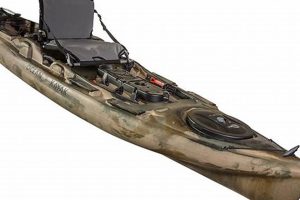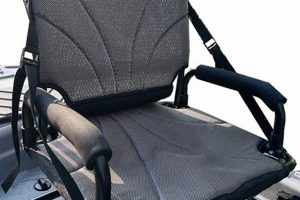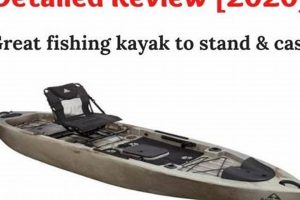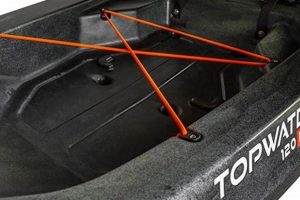Elevated angling platforms designed for stability and hands-free casting represent a specialized segment of the fishing kayak market. These watercraft often incorporate design features like wider hulls, outriggers, and non-slip surfaces to facilitate a secure, upright fishing experience. This style of kayak enables anglers to gain a better vantage point for spotting fish, as well as providing greater freedom of movement for casting and landing.
The evolution of these specialized kayaks stems from the desire for a more dynamic and effective fishing experience. Improved stability and an elevated perspective offer significant advantages over traditional seated kayak fishing. This design approach allows for a more active fishing style, mimicking the experience of wading or fishing from a larger vessel, while maintaining the maneuverability and shallow-water access inherent to kayaks. This can lead to increased catch rates and overall fishing enjoyment.
Further exploration of specific design features, materials, and manufacturers within this category will provide a more comprehensive understanding of the advantages and potential drawbacks of elevated fishing kayaks. Considerations such as weight capacity, portability, and price point are also essential factors influencing purchasing decisions.
Tips for Elevated Kayak Angling
Optimizing the experience of fishing from an elevated platform requires careful consideration of various factors. The following tips offer guidance on maximizing stability, safety, and fishing success.
Tip 1: Prioritize Stability: Begin by practicing on calm, shallow water to develop a sense of balance. Consider using a kayak with a wider hull or outriggers for enhanced stability.
Tip 2: Select Appropriate Gear: Opt for shorter rods and reels designed for vertical jigging or casting in tighter spaces. A landing net with an extended handle is also recommended.
Tip 3: Distribute Weight Evenly: Ensure gear and equipment are distributed evenly within the kayak to maintain balance and prevent tipping. Use designated storage areas.
Tip 4: Utilize an Anchor or Stake-Out Pole: Maintaining position in a desired fishing area is crucial. An anchor or stake-out pole will prevent drifting and optimize casting opportunities.
Tip 5: Practice Proper Casting Techniques: Adapt casting motions to the elevated stance, focusing on shorter, controlled casts to maintain balance and accuracy.
Tip 6: Wear a Personal Flotation Device (PFD): Safety should always be paramount. A PFD is essential in case of accidental falls or capsizing.
Tip 7: Check Weather Conditions: Wind and waves can significantly impact stability. Avoid fishing in adverse conditions, especially when starting with elevated angling.
By adhering to these guidelines, anglers can significantly enhance their safety and enjoyment while maximizing the benefits of elevated kayak fishing.
These practical tips provide a foundation for successful elevated kayak angling. Further research and on-the-water experience will contribute to continued improvement and confidence.
1. Stability
Stability forms the cornerstone of a successful standing fishing kayak experience. Without a stable platform, the advantages of an elevated perspective and hands-free fishing are negated. Compromised stability not only hinders casting accuracy and fish fighting effectiveness but also presents significant safety risks. Consider the scenario of hooking a large fish while standing in an unstable kayak; the sudden shift in weight and the ensuing struggle could easily lead to capsizing. Similarly, even a slight change in water conditions, like a passing boat wake, can destabilize a poorly designed kayak, jeopardizing the angler’s safety.
Several factors contribute to kayak stability. Hull design plays a crucial role, with wider, flatter hulls generally offering greater initial stability. Outriggers, providing additional points of contact with the water, further enhance stability, especially in challenging conditions. The angler’s weight distribution also influences stability; maintaining a low center of gravity and distributing weight evenly across the kayak are vital for preventing tipping. Specialized features, like non-slip deck surfaces and strategically placed grab handles, contribute to stability by providing secure footing and points of contact for maintaining balance.
Understanding the factors influencing stability is essential for informed decision-making when selecting a standing fishing kayak. Prioritizing stability ensures not only a more effective fishing experience but also, critically, a safer one. While features like maneuverability and storage capacity are important considerations, they should not overshadow the fundamental requirement for a stable platform that enables anglers to confidently stand and fish.
2. Elevated Perspective
The elevated perspective afforded by a standing fishing kayak, potentially of the “Fissot” brand or type, represents a significant departure from traditional seated kayak fishing. This higher vantage point offers distinct advantages for the angler, impacting key aspects of the fishing experience, from locating fish to executing accurate casts.
- Improved Sight Fishing:
Standing above the waterline provides a clearer view into the depths, allowing anglers to spot fish more easily. This is particularly advantageous in clear, shallow water environments where fish can be observed before casting. Consider the scenario of targeting bonefish on a shallow flat. From a seated position, the angler’s view is limited by the water’s surface and the kayak’s hull. Standing, however, provides a commanding view, enabling the angler to spot the subtle movements and flashes of bonefish in the distance. This enhanced visibility translates to more targeted casts and increased fishing success.
- Enhanced Casting Accuracy:
The elevated position provides a wider casting arc and facilitates more precise casting. This is especially beneficial when targeting specific structures or pockets of water. Imagine casting to a submerged log in a narrow creek. From a seated position, the cast may be obstructed by overhanging branches or the kayak’s own structure. Standing allows for a clearer casting lane and greater control over the lure’s trajectory, improving accuracy and minimizing snags.
- Superior Fish Fighting Control:
An elevated stance provides greater leverage and control when fighting fish. The angler can better manage the rod and line, applying pressure more effectively. Visualizing the struggle of landing a powerful fish emphasizes this advantage. Standing provides the angler with the stability and leverage needed to maintain balance and control the fish, reducing the risk of line breakage or the fish escaping.
- Increased Awareness of Surroundings:
Standing offers a broader view of the surrounding environment, allowing anglers to navigate more effectively and identify potential hazards. This heightened awareness is beneficial for both safety and fishing strategy. Consider navigating a complex waterway with submerged obstacles or changing currents. The elevated perspective allows the angler to anticipate these challenges, adjusting their course and fishing approach accordingly. This heightened awareness contributes to both a safer and more productive fishing experience.
These interconnected facets of the elevated perspective contribute significantly to the effectiveness and enjoyment of fishing from a standing kayak. While stability and maneuverability remain crucial considerations, the enhanced visual awareness and control afforded by standing elevate the angling experience, making it a preferred choice for many anglers seeking an active and engaging approach to kayak fishing.
3. Hands-Free Fishing
Hands-free fishing represents a significant advantage offered by specialized kayaks designed for standing. This capability enhances angling effectiveness and safety, differentiating the experience from traditional seated kayak fishing where hands are frequently occupied with paddle management. The ability to maintain a stable, upright position while keeping hands free to manipulate rods, reels, and tackle contributes significantly to a more dynamic and responsive fishing approach. The following facets explore the components, examples, and implications of hands-free fishing within the context of specialized kayaks.
- Enhanced Lure Control:
Maintaining constant contact with the lure is crucial for detecting subtle strikes and reacting quickly. Hands-free operation allows for immediate adjustments to lure retrieval speed, depth, and action, maximizing presentation effectiveness. Consider the scenario of working a topwater lure across a weedy surface. Hands-free operation enables the angler to impart nuanced twitches and pauses, mimicking the movements of a struggling insect and enticing strikes from predatory fish. This level of control is often compromised in seated kayak fishing due to the need to manage the paddle.
- Improved Hookset Speed:
Reacting swiftly to a fish strike is essential for securing a solid hookset. Hands-free fishing minimizes the delay between strike detection and hookset, increasing the likelihood of landing the fish. Imagine the scenario of a bass striking a jig. With hands already positioned on the rod, the angler can instantly set the hook with a sharp upward motion, ensuring the hook penetrates firmly. This rapid response is often difficult to achieve in a seated kayak where the angler must first adjust their grip and position before setting the hook.
- Efficient Tackle Management:
Changing lures, adjusting lines, and managing tackle are crucial aspects of angling. Hands-free fishing streamlines these tasks, allowing for quick adjustments and minimizing disruption to the fishing process. Consider the need to switch from a crankbait to a plastic worm due to changing water conditions or fish behavior. With hands readily available, the angler can quickly make the switch without having to reposition themselves or set down the paddle. This efficiency is crucial for maximizing fishing time and adapting to evolving conditions.
- Increased Safety:
Maintaining balance in a standing kayak is paramount for safety. Hands-free operation allows the angler to use their hands for stabilization, bracing against unexpected movements or adjusting weight distribution. This added stability is especially crucial in challenging conditions such as windy weather or choppy water. Visualize the scenario of a sudden shift in weight caused by a hooked fish. With hands free, the angler can instantly brace themselves, maintaining balance and preventing a potential fall. This aspect of safety is significantly compromised when hands are occupied with a paddle.
These interconnected facets of hands-free fishing highlight its significant contribution to the effectiveness and safety of angling from specialized kayaks. While the elevated perspective and specialized design features of these kayaks offer distinct advantages, the ability to fish hands-free enhances control, responsiveness, and safety, creating a more dynamic and engaging fishing experience. This capability differentiates specialized standing kayaks from traditional seated models, offering a distinct advantage for anglers seeking a more active and involved approach.
4. Maneuverability
Maneuverability represents a critical attribute influencing the effectiveness of a standing fishing kayak, potentially of the “Fissot” brand or type. The ability to precisely position the kayak, navigate tight spaces, and respond quickly to changing conditions directly impacts fishing success and overall experience. A highly maneuverable kayak enables anglers to exploit diverse fishing environments, from shallow creeks and weed-lined shorelines to open water scenarios. This adaptability is particularly relevant in standing fishing kayaks where maintaining stability while maneuvering is essential. Consider navigating a narrow, winding creek choked with submerged logs and overhanging branches. A highly maneuverable kayak allows the angler to navigate these obstacles effectively, reaching prime fishing locations inaccessible to less agile craft. Conversely, a less maneuverable kayak limits access and compromises fishing opportunities.
Several factors influence kayak maneuverability. Hull design plays a pivotal role; shorter kayaks with a defined keel or tracking fin generally exhibit greater maneuverability. Consider a shorter kayak with a pronounced keel. The keel provides directional stability, allowing for efficient tracking and responsive turning. Conversely, a longer, wider kayak without a keel may track less effectively and require greater effort to turn, hindering precise positioning in challenging environments. Paddle length and blade shape also contribute to maneuverability. Longer paddles provide greater leverage and reach, while shorter paddles offer quicker, more responsive strokes for precise adjustments in tight quarters. The angler’s skill and experience also play a significant role; proficient paddling technique and knowledge of water dynamics maximize the kayak’s inherent maneuverability. Furthermore, weight distribution within the kayak influences maneuverability. Evenly distributed weight optimizes performance, while uneven weight distribution can hinder tracking and responsiveness.
The relationship between maneuverability and the effectiveness of a standing fishing kayak is significant. While stability and an elevated perspective are key advantages of these specialized kayaks, maneuverability determines the angler’s ability to exploit these advantages in diverse environments. The confluence of stability and maneuverability allows anglers to confidently stand and fish in challenging locations, maximizing their reach and effectiveness. Compromised maneuverability, however, limits access to prime fishing spots and hinders the overall angling experience. Therefore, careful consideration of factors influencing maneuverability, such as hull design, paddle selection, and weight distribution, is essential when selecting a standing fishing kayak. Understanding these factors empowers anglers to choose a kayak optimized for their specific fishing needs and target environments, maximizing both enjoyment and success on the water.
5. Specialized Design
Specialized design differentiates standing fishing kayaks, potentially including the “Fissot” brand or type, from conventional sit-on-top or sit-in models. These design adaptations prioritize stability, functionality, and angler performance in a standing position, enabling a more active and engaging fishing experience. Careful consideration of these specialized features is crucial for informed decision-making, aligning kayak selection with individual angling styles and target environments.
- Hull Design:
Wider, flatter hulls and enhanced secondary stability features, such as pontoon-style designs or outriggers, maximize stability for standing and casting. A wider hull provides a larger base of support, reducing the tendency to tip, while features like outriggers further enhance stability by increasing the kayak’s effective width. This stability is crucial for maintaining balance during casting, fighting fish, and navigating varied water conditions.
- Deck Features:
Non-slip surfaces, strategically placed grab handles, and recessed footwells contribute to secure footing and balance. Non-slip surfaces provide traction, minimizing the risk of slips and falls, especially in wet conditions. Grab handles offer additional points of contact for maintaining balance during unexpected movements or rough water. Recessed footwells provide a secure and stable platform for standing, enhancing overall stability and control.
- Integrated Features:
Purpose-built standing platforms, elevated seating systems, and specialized mounting points for fishing accessories optimize functionality. Elevated seating systems allow for transitioning between seated and standing positions, providing flexibility for different fishing scenarios. Specialized mounting points accommodate rod holders, fish finders, and other essential gear, enhancing angling efficiency and organization. Integrated features such as these streamline the fishing experience, maximizing functionality and convenience.
- Material Selection:
Durable, lightweight materials, such as high-density polyethylene or composites, contribute to performance and portability. High-density polyethylene offers excellent impact resistance and durability, ensuring longevity in demanding environments. Composite materials, while often more expensive, provide a lighter weight option, enhancing portability and maneuverability. The choice of material influences not only the kayak’s durability and performance but also its overall weight and ease of transport.
These interconnected design elements contribute significantly to the functionality and effectiveness of standing fishing kayaks. While hull design provides the foundation for stability, deck features enhance safety and control, and integrated features optimize functionality for a specialized fishing experience. The selection of appropriate materials balances durability, performance, and portability. Careful consideration of these specialized design features ensures a safe, stable, and effective platform for standing and fishing, maximizing both enjoyment and success on the water. The interplay of these features distinguishes specialized standing fishing kayaks from conventional models, offering a distinct advantage for anglers seeking a more active and engaging approach.
Frequently Asked Questions
This section addresses common inquiries regarding specialized fishing kayaks designed for standing, potentially including models of the “Fissot” brand or type. Understanding these key aspects facilitates informed decision-making and promotes a safer, more effective fishing experience.
Question 1: How is stability maintained in a standing fishing kayak?
Stability is achieved through a combination of design elements, including wider hulls, outriggers, and a low center of gravity. Angler weight distribution and calm water conditions also contribute significantly to stability. Regular practice is recommended to develop balance and confidence.
Question 2: What are the advantages of fishing from an elevated position?
An elevated position provides enhanced visibility for spotting fish, improved casting accuracy, greater leverage for fighting fish, and increased awareness of surrounding hazards and navigational markers.
Question 3: What safety precautions should be taken when standing in a fishing kayak?
Wearing a personal flotation device (PFD) is paramount. Practicing in calm, shallow water before venturing into more challenging conditions is highly recommended. Distributing weight evenly and avoiding sudden movements are crucial for maintaining balance.
Question 4: What type of fishing is best suited for a standing fishing kayak?
These kayaks excel in sight fishing scenarios, fly fishing, and lure casting where an elevated perspective and hands-free operation provide distinct advantages. They are particularly well-suited for shallow water environments such as flats, rivers, and estuaries.
Question 5: What factors should be considered when choosing a standing fishing kayak?
Key considerations include stability, maneuverability, weight capacity, storage options, and the integration of features like rod holders and mounting points for accessories. Individual fishing style and target environments should also influence selection.
Question 6: Are specialized standing fishing kayaks more difficult to paddle than traditional kayaks?
While the wider hull design may slightly reduce top-end speed, these kayaks are generally designed for efficient paddling. Stability in a standing position allows for powerful, unimpeded strokes, enhancing maneuverability in various water conditions.
Addressing these common inquiries provides a foundational understanding of specialized standing fishing kayaks. Further research and consultation with experienced anglers can offer additional insights tailored to individual needs and preferences. Prioritizing stability and safety remains paramount for an enjoyable and productive on-the-water experience.
Further exploration of specific models, manufacturers, and advanced techniques can enhance understanding and facilitate informed purchasing decisions.
Conclusion
Specialized fishing kayaks designed for standing offer distinct advantages for anglers seeking an active and engaging approach. Prioritizing stability through design features like wider hulls and outriggers ensures a secure platform for casting and fighting fish. The elevated perspective enhances sight fishing, improves casting accuracy, and provides greater control during fish retrieval. Hands-free operation streamlines tackle management and maximizes responsiveness to strikes. Maneuverability is crucial for navigating diverse environments, while specialized design features, such as integrated rod holders and non-slip surfaces, optimize functionality and safety. Careful consideration of these factors empowers anglers to select a kayak aligned with individual needs and target fishing environments.
The evolution of kayak fishing continues to drive innovation in design and technology. As anglers seek increasingly specialized equipment, platforms optimized for standing represent a significant advancement in the pursuit of a more dynamic and effective fishing experience. Further exploration of specific models, manufacturers, and advanced techniques will empower anglers to fully realize the potential of these specialized kayaks. A commitment to safety and responsible angling practices remains paramount as anglers explore new frontiers in the sport.






